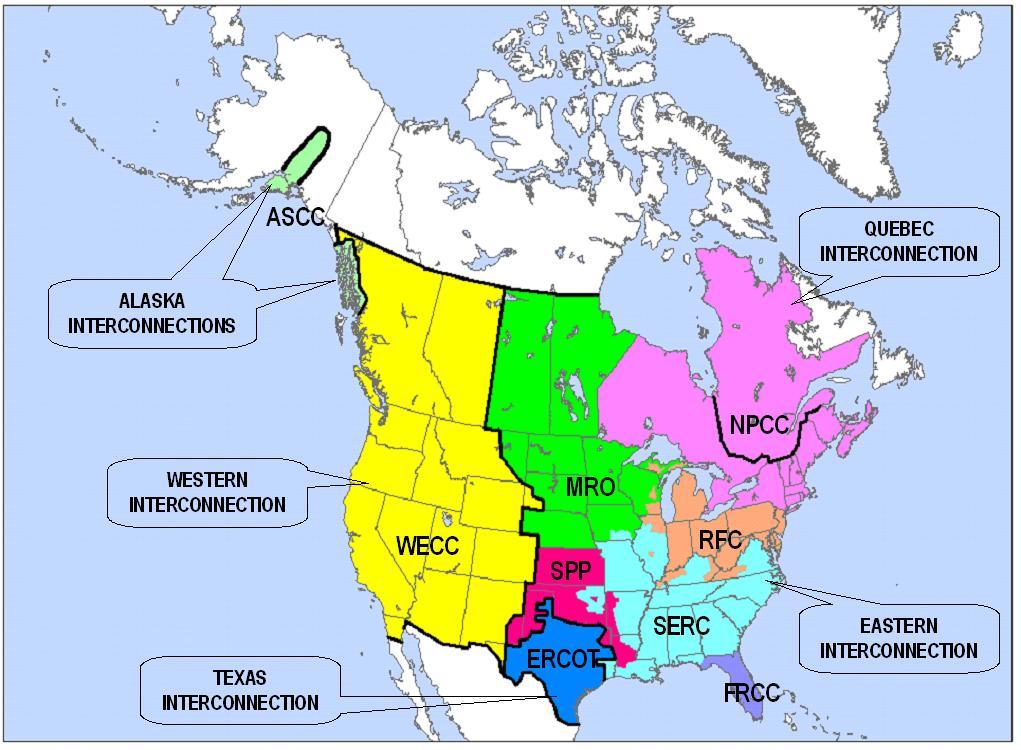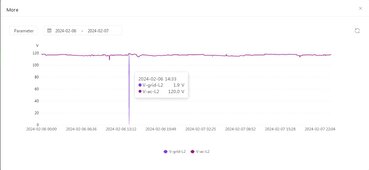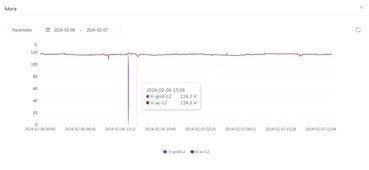It's rare but it does happen. Utilities do it to prevent too much solar power from destabilizing the grid. It can happen more frequently in small grids with high solar penetration (e.g. Hawaii). Utilities have been able to do this since the original UL1741 compliant grid-tied inverters that simply shut off when the grid frequency is too high. So, the proportional PV curtailment functions in UL1741SA/SB required in newer inverters is actually an improvement because having too many inverters suddenly shut off can also cause grid instability. Here is a paper on PV curtailment from 2018 (https://www.sciencedirect.com/science/article/pii/S0038092X20309166) with some historical data.This is tin foil hat talk.
The utility grid frequency is VERY tightly controlled. The utility is not going to shift it for some solar inverters. That would screw up people's clocks and the phasing of all the utilities power sources, including the interconnection of other grids across a wide area.
The synchronous grid:

Wide area synchronous grid - Wikipedia
en.wikipedia.org
The utility is not gong to screw with that to play with your inverters.
Mike C.
You are using an out of date browser. It may not display this or other websites correctly.
You should upgrade or use an alternative browser.
You should upgrade or use an alternative browser.
Jack Ricard on UL-1741 and utility tapering, thoughts?
- Thread starter 941all-electric
- Start date
Yes. Most of the feed in source is utility controlled though, overproduction raises voltage, if the utilities are slow to adjust their own production down, they can bump off customer production.Don’t they publicly report feed in from all sources (including solar, peaker plants, etc) and grid demand?
So they would have to cook some books/deal with a paper trail.
No, a grid tie inverter will produce maximum output unless told otherwise.Are you sure that this is not some sort of Urban Myth
Inverters are constantly adjusting their output according to what the Grid is producing.
zanydroid
Solar Wizard
Sure, this is vaguely reminiscent of Enron tricks.Yes. Most of the feed in source is utility controlled though, overproduction raises voltage, if the utilities are slow to adjust their own production down, they can bump off customer production.
Perhaps a properly designed market would help. It would make sense for utility scale grid tie solar vs utility scale peaking plants (assuming wholesale vs wholesale comparison). You would not want to run peaking plants when there's a glut of solar, that would be economically unwise.
With net metering at residential rates market based won't work, in part b/c it's inherently distorted. Paying extra gas to run peaker plant is probably cheaper than the retail compensated generation you are knocking off the grid with the shenanigans. You would need some power police to make sure there is no cheating.
Ampster
Renewable Energy Hobbyist
I think the economics take care of that. At least in California peakers are the most expensive and least desireable in terms of Renewable Portfolio Standards. I think when solar has sunsetted there is now significant battery storage at least for a few hours worth of generattion. By then Combined Cycle plants have ramped up.You would not want to run peaking plants when there's a glut of solar, that would be economically unwise.
zanydroid
Solar Wizard
Not sure we still have a lot of combined cycle plants in California. Sure, they can spin up & to run constantly for overnight base load (and then spin down after that), but only running them at night rather than all day means the return on capital is a lot worse. And those already need more equipment per kW than a peaker plant.By then Combined Cycle plants have ramped up.
Ampster
Renewable Energy Hobbyist
They replaced two ocean cooled plants on the coast in El Segundo that I know of. A Redondo Beach plant closed. Something changed about one along the coast north of Monterey. I don't know the numbers but the big growth in California has been battery plants and more are in the works.Not sure we still have a lot of combined cycle plants in California.
zanydroid
Solar Wizard
My source on this is from reading a somewhat recent doc on the average efficiency of gas plants in California. It had gone down because of the economics issues I mentioned. One of the surprising things was that they shutdown somewhat new plants. Not sure exactly why. Maybe ripping it out and moving it elsewhere/not paying to keep staff on site to maintain it was more profitable.They replaced two ocean cooled plants on the coast in El Segundo that I know of. A Redondo Beach plant closed. Something changed about one along the coast north of Monterey. I don't know the numbers but the big growth in California has been battery plants and more are in the works.
Battery plants will probably cycle every day to the financial planning targets. The operations costs are probably pretty good too. It can just plug into where you already were going to put solar, and there are not many moving parts / fuel to worry about.
Ampster
Renewable Energy Hobbyist
I would love to read that source. Are you saying gas plant efficiency went down? Or that the percentage of combined cycle gas plants went down. I thought the reason they were building combined cycle plants was because of the efficiency and the quick ramp for part of the cycle?My source on this is from reading a somewhat recent doc on the average efficiency of gas plants in California. It had gone down because of the economics issues I mentioned.
Nobodybusiness
Collecting the leftovers of the Great Sky Reactor.
I tend to have to agree with you on this.This is tin foil hat talk.
The utility grid frequency is VERY tightly controlled. The utility is not going to shift it for some solar inverters. That would screw up people's clocks and the phasing of all the utilities power sources, including the interconnection of other grids across a wide area.
The synchronous grid:

Wide area synchronous grid - Wikipedia
en.wikipedia.org
The utility is not gong to screw with that to play with your inverters.
Mike C.
The only way that would even work is if somehow the smart meter could freq shift.
They couldn’t very well do it on an entire line.
That would mean the meter is basically a huge VFD capable of the entire service power. It would be grid AC to DC to VFD AC again.The only way that would even work is if somehow the smart meter could freq shift.
Nope, not happening. The cost and losses would be intolerable.
Mike C.
zanydroid
Solar Wizard
The percentage of combined cycle went down, so the overall efficiency went down across the fleet of gas burning plants in the state.I would love to read that source. Are you saying gas plant efficiency went down? Or that the percentage of combined cycle gas plants went down. I thought the reason they were building combined cycle plants was because of the efficiency and the quick ramp for part of the cycle?
Ampster
Renewable Energy Hobbyist
Good to know. I was obviously basing my statistics on the two plants I used to drive by, and assumed that applied across the state.The percentage of combined cycle went down, so the overall efficiency went down across the fleet of gas burning plants in the state.
Nobodybusiness
Collecting the leftovers of the Great Sky Reactor.
Yes I’m aware.That would mean the meter is basically a huge VFD capable of the entire service power. It would be grid AC to DC to VFD AC again.
Nope, not happening. The cost and losses would be intolerable.
Mike C.
Just stating for the thread that it’s not probable.
teal95
Solar Enthusiast
I agree, I don't see any way frequency shift can ever be implemented as the entire connected grid would have to have it's frequency shifted. Frequency shift could be a natural frequency (less load is going to make mechanical generators speed up) but we don't see that happening on a regular basis so there must be other controls.
With voltage also is a direct feedback, it's fairly easy to have fine control by adjustable transformer "taps" as it could be done at substations or even individual controls at each transformer in the system.
With voltage also is a direct feedback, it's fairly easy to have fine control by adjustable transformer "taps" as it could be done at substations or even individual controls at each transformer in the system.
robby
Photon Vampire
- Joined
- May 1, 2021
- Messages
- 4,129
I don’t know about your inverter but the Sol-Ark is running at the Value of the Grid so long as the Grid stays within the Min/Max Values. If the Grid is not being used it Runs at the Nominal Value I set for operating voltage which in my case is 240/120V. If it’s operating within the Max and Min parameters it’s fine and the voltage will Rise or Fall with the Grid but if they are exceeded it then it switches to Battery until the utility voltage stabilizes.No, a grid tie inverter will produce maximum output unless told otherwise.
Here is The Inverter during a Blackout and it has gone exactly to my Nominal voltage value.

Here is the measurement with the Grid Back but still low but within my Minimum Value.
Note it is not trying to compensate for the 114V.

Sorry but I can't find a graph with High Grid voltage, but I have seen it and if the Grid is at 250/125V the inverter outputs 250/125V. It will only react when the voltage passes the Maximum set point on the Inverter. If I was selling back to the Grid it would Increase the voltage slightly higher than the 250V.
Last edited:
Sure, the inverter has to have a slightly higher voltage than grid, and will push all the current it can unless told otherwise.I don’t know about your inverter but the Sol-Ark is running at the Value of the Grid so long as the Grid stays within the Min/Max Values. If the Grid is not being used it Runs at the Nominal Value I set for operating voltage which in my case is 240/120V. If it’s operating within the Max and Min parameters it’s fine and the voltage will Rise or Fall with the Grid but if they are exceeded it then it switches to Battery until the utility voltage stabilizes.
Here is The Inverter during a Blackout and it has gone exactly to my Nominal voltage value.
View attachment 203054
Here is the measurement with the Grid Back but still low but within my Minimum Value.
Note it is not trying to compensate for the 114V.
View attachment 203055
Sorry but I can't find a graph with High Grid voltage, but I have seen it and if the Grid is at 250/125V the inverter outputs 250/125V. It will only react when the voltage passes the Maximum set point on the Inverter. If I was selling back to the Grid it would Increase the voltage slightly higher than the 250V.
When charging batteries the grid tie inverter has to be told to reduce current. It’s default is maximum current possible.
The Sol-Ark is a hybrid inverter, different scenario to a grid-tie inverter.


